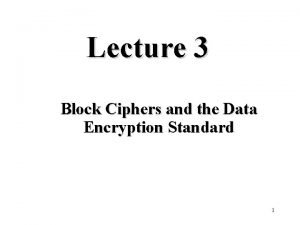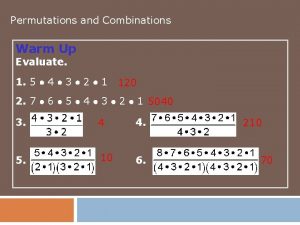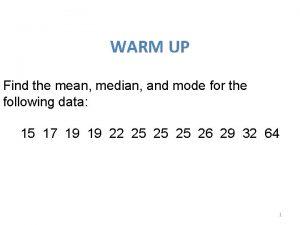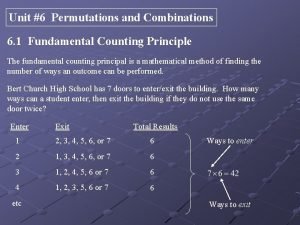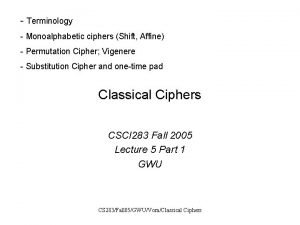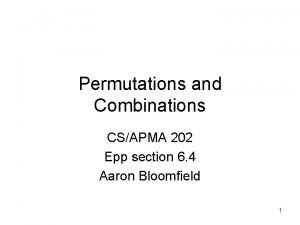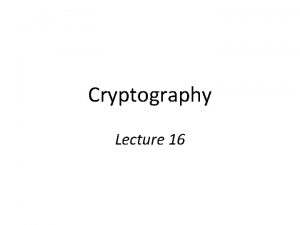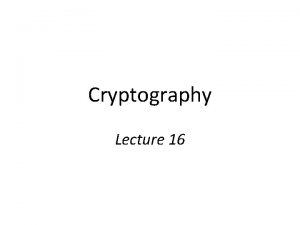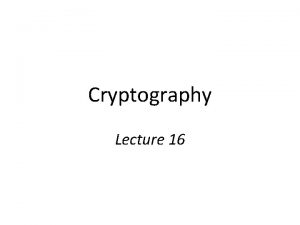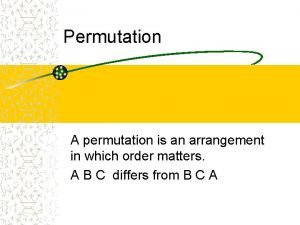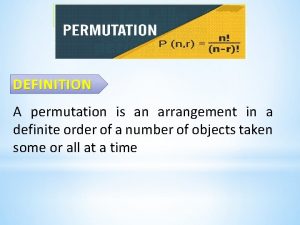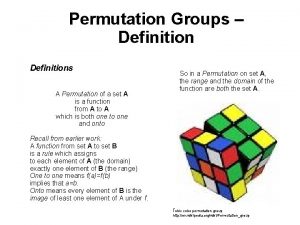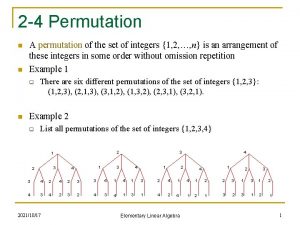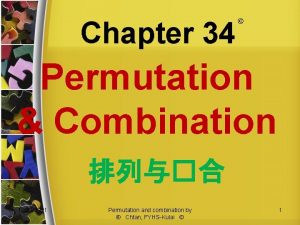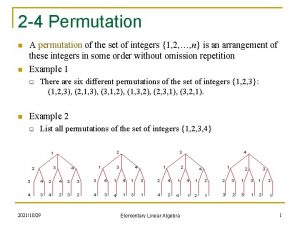Cryptography Lecture 17 Recall Want keyed permutation F

















- Slides: 17

Cryptography Lecture 17

Recall… • Want keyed permutation F: {0, 1}n x {0, 1}l – n = key length, l = block length • Want Fk (for uniform, unknown key k) to be indistinguishable from a uniform permutation over {0, 1}l

Designing block ciphers • If x and x’ differ in one bit, what should be the relation between Fk(x) and Fk(x’)? – How many bits should change (on average)? – Which bits should change? • How to achieve this?

Confusion/diffusion • “Confusion” – Small change in input should result in local, “random” change in output • “Diffusion” – Local change in output should be propagated to entire output

SPNs • Build “random-looking” permutation on large input from random permutations on small inputs • E. g. , assume 8 -byte block length Fk(x) = fk 1(x 1) fk 2(x 2) … fk 8(x 8), where each f is a random permutation – How long is k?

SPN fk 1 fk 2 . . . Is this a pseudorandom function?

SPN • This has confusion but no diffusion – Add a mixing permutation…

SPN fk 1 fk 2 . . .

Invertibility • Note that the structure is invertible (given the key) since the f’s are permutations

SPN • Mixing permutation is public – Chosen to ensure good diffusion • Does this give a pseudorandom function? • What if we repeat for another round (with independent, random functions)? – What is the minimal # of rounds we need? – Avalanche effect

SPN • Using random f’s is not practical – Key would be too large • Instead, use f’s of a particular form – fki(x) = Si(ki x), where Si is a public permutation – Si are called “S-boxes” (substitution boxes) – XORing the key is called “key mixing” – Note that this is still invertible (given the key)


Avalanche effect • Design S-boxes and mixing permutation to ensure avalanche effect – Small differences should eventually propagate to entire output • S-boxes: 1 -bit change in input causes ≥ 2 -bit change in output – Not so easy to ensure! • Mixing permutation – Each bit output from a given S-box should feed into a different S-box in the next round

SPN • One round of an SPN involves – Key mixing • Ideally, round keys are independent • In practice, derived from a master key via key schedule – Substitution (S-boxes) – Permutation (mixing permutation) • r-round SPN has r rounds as above, plus a final key-mixing step – Why? • Invertible regardless of how many rounds…

Key-recovery attacks • Key-recovery attacks are even more damaging than distinguishing attacks – As before, a cipher is secure only if the best keyrecovery attack takes time 2 n – A fast key-recovery attack represents a “complete break” of the cipher

Key-recovery attack, 1 -round SPN • Consider first the case where there is no final key-mixing step – Possible to get the key immediately! • What about a full 1 -round SPN? – Attack 1: for each possible 1 st-round key, get corresponding 2 nd-round key • Continue process of elimination • Complexity 2 l for key of length 2 l

Key-recovery attack, 1 -round SPN • Better attack: work S-box-by-S-box – Assume 8 -bit S-box – For each 8 bits of 1 st-round key, get corresponding 8 bits of 2 nd-round key • Continue process of elimination • Complexity?
 Keyed permutation
Keyed permutation Keyed permutation
Keyed permutation Typist initials example
Typist initials example Memo initials
Memo initials Keyed and keyless transposition ciphers
Keyed and keyless transposition ciphers 01:640:244 lecture notes - lecture 15: plat, idah, farad
01:640:244 lecture notes - lecture 15: plat, idah, farad Des
Des Example of combination
Example of combination Permutation without repetition
Permutation without repetition Permutation and combination meaning
Permutation and combination meaning 4 letter call signs
4 letter call signs Permutation with restrictions
Permutation with restrictions Bit permutation
Bit permutation Ciphers
Ciphers Combination or permutation quiz
Combination or permutation quiz What is distinguishable permutation meaning
What is distinguishable permutation meaning What is 5 factorial
What is 5 factorial Combinations and permutations
Combinations and permutations






